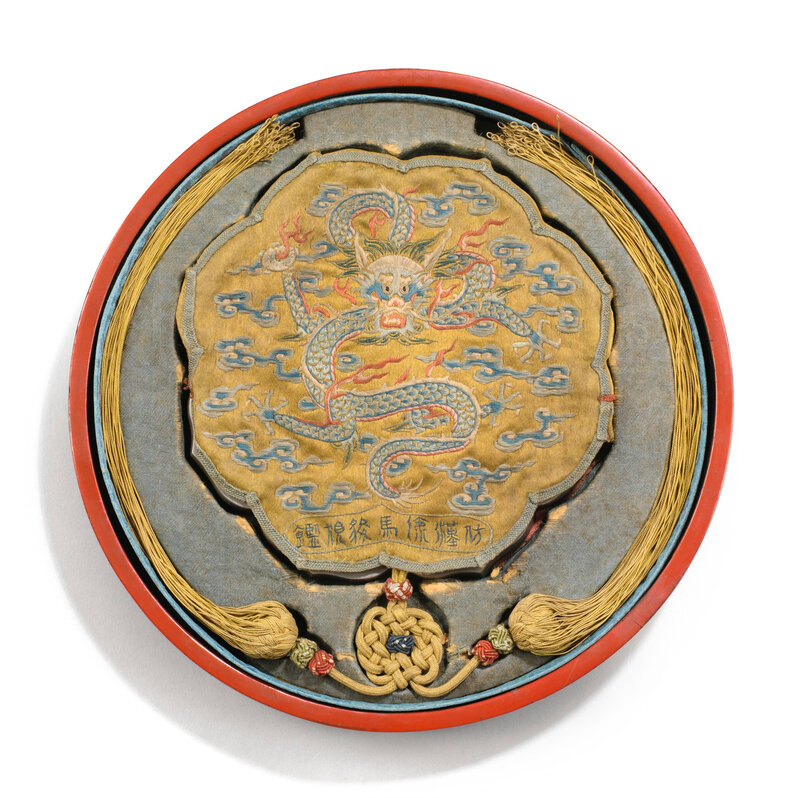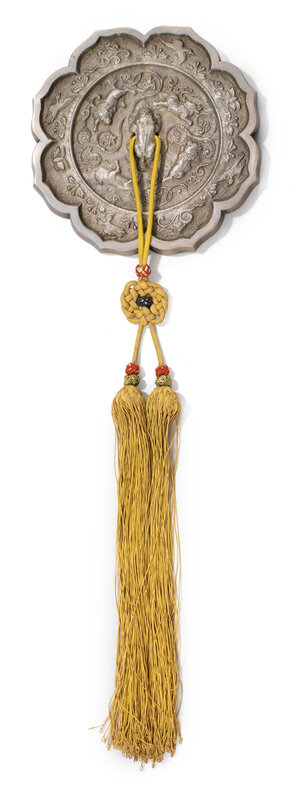de forme polylobée, la prise centrale en forme d'animal fabuleux couché accueillant un double pompon en soie jaune, entourée de quatre animaux des mers parmi les pampres de vigne, les bords animés d'oiseaux et de papillons en vol, dans un écrin sur mesure en soie jaune brodée et décorée sur les deux faces d'un dragon à cinq griffes tenant la perle enflammée et portant l'inscription Fang Han xiang ma jun ni jian dans un cartouche, dans sa boîte en laque trois-couleurs, à décor de lotus stylisés sur la bordure, la base laquée noire (3).
Ancienne collection particulière française.
A rare Tang-style bronze mirror, silk pouch within a carved three-colour lacquer box, Qing dynasty, Qianlong period
Provenance: This bronze mirror and lacquer box share the same provenance as the wonderful Yangcai vase offered in PF1837, lot 1. It had been left to the great-grandparents of the present owners by an uncle and appears among the listed contents of his Paris apartment after he passed away in 1947. It is listed along with several other Chinese and Japanese objects including other Chinese porcelains, two dragon robes, a yellow silk textile, and the wonderful Yangcai vase offered in our sale PF1837, lot 1.
While the exact provenance of the vase and the other Chinese and Japanese pieces before 1947 cannot be traced, the receipt of a Satsuma censer acquired as a weddding gift in the 1867 Universal Exhibition in Paris by an ancestor of the family suggests an active interest in Asian art at a very early date. Similarly, this bronze mirror and lacquer box may well have been acquired in Paris in the late 19th century when the arrival of Asian works of art initiated a fashion for Japanese and Chinese art.
Note: During the Qing dynasty, rare, precious and exotic works of art including antiquities were kept in curiosity cabinets of varying sizes and shape. While on the exterior these small boxes or cabinets revealed nothing of their contexts, once opened the objects contained within would reveal themselves being ingeniously fitted into the contained spaced. This mirror is just such an example of which several have survived in the Imperial collection. The yellow pouch bears the mirror's title though not Han in style but Tang, it was considered rare and may even have been part of the Imperial collection of Antiquities as two similarly shaped bronze mirrors documented in the imperial catalogue Xiqing gujian, which was compiled on the Emperor Qianlong's order by Liang Shizheng and others between the 14th (1749) and 20th (1755) year of his reign (Fig. 1 Caption: Xiqing gujian [Catalogue of Chinese ritual bronzes in the collection of the Qianlong Emperor], juan 40, pls. 57 and 58). This bronze mirror presented here appears to have been part of a larger group of objects all fitted into different trays of a tiered carved three-colour lacquer box that was especially made and fitted to accommodate the shape and size of the mirrors, see also another bronze mirror from the Imperial collection similarly kept in an elaborately embroidered silk pouch, compare The Imperial Packing Art of the Qing Dynasty, Beijing, 2000, cat. no. 119. Multiple bronze mirrors from the Imperial collection often appear in boxes made just for bronze mirrors, compare Tao Wang, Mirroring China's Past. Emperors, Scholars and their Bronzes, Chicago, 2018, pls. 93-96. Yet other examples are illustrated in Jean-Paul Desroches, La Cité Interdite. Vie de Cour des Empereurs et Impératrices de Chine, Monaco, 2017, p. 96 and cat. nos. 118 and 119.

/https%3A%2F%2Fprofilepics.canalblog.com%2Fprofilepics%2F1%2F0%2F100183.jpg)
/https%3A%2F%2Fstorage.canalblog.com%2F03%2F02%2F119589%2F96711876_o.jpg)
/https%3A%2F%2Fstorage.canalblog.com%2F11%2F31%2F119589%2F94773502_o.jpg)
/https%3A%2F%2Fstorage.canalblog.com%2F20%2F83%2F119589%2F94772815_o.jpg)
/https%3A%2F%2Fstorage.canalblog.com%2F26%2F72%2F119589%2F75604929_o.jpg)
/https%3A%2F%2Fstorage.canalblog.com%2F59%2F60%2F119589%2F26458628_o.jpg)











/image%2F1371349%2F20240423%2Fob_af8bb4_telechargement-6.jpg)
/image%2F1371349%2F20240423%2Fob_b6c4a6_telechargement.jpg)
/image%2F1371349%2F20240416%2Fob_65a1d8_telechargement-31.jpg)
/image%2F1371349%2F20240331%2Fob_7209d9_117-1.jpg)